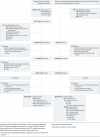Violent reinjury and mortality among youth seeking emergency department care for assault-related injury: a 2-year prospective cohort study
- PMID: 25365147
- PMCID: PMC4306452
- DOI: 10.1001/jamapediatrics.2014.1900
Violent reinjury and mortality among youth seeking emergency department care for assault-related injury: a 2-year prospective cohort study
Abstract
Importance: Violence is a leading cause of morbidity and mortality among youth, with more than 700000 emergency department (ED) visits annually for assault-related injuries. The risk for violent reinjury among high-risk, assault-injured youth is poorly understood.
Objective: To compare recidivism for violent injury and mortality outcomes among drug-using, assault-injured youth (AI group) and drug-using, non-assault-injured control participants (non-AI group) presenting to an urban ED for care.
Design, setting, and participants: Participants were enrolled in a prospective cohort study from December 2, 2009, through September 30, 2011, at an urban level I ED and followed up for 24 months. We administered validated measures of violence and substance use and mental health diagnostic interviews and reviewed medical records at baseline and at each point of follow-up (6, 12, 18, and 24 months).
Exposure: Follow-up over 24 months.
Main outcomes and measures: Use of ED services for assault or mortality measured from medical record abstraction supplemented with self-report.
Results: We followed 349 AI and 250 non-AI youth for 24 months. Youth in the AI group had almost twice the risk for a violent injury requiring ED care within 2 years compared with the non-AI group (36.7% vs 22.4%; relative risk [RR], 1.65 [95% CI, 1.25-2.14]; P<.001). Two-year mortality was 0.8%. Poisson regression modeling identified female sex (RR, 1.30 [95% CI, 1.02-1.65]), assault-related injury (RR, 1.57 [95% CI, 1.19-2.04), diagnosis of a drug use disorder (RR, 1.29 [95% CI, 1.01-1.65]), and posttraumatic stress disorder (RR, 1.47 [95% CI, 1.09-1.97]) at the index visit as predictive of ED recidivism or death within 24 months. Parametric survival models demonstrated that assault-related injury (P<.001), diagnosis of posttraumatic stress disorder (P=.008), and diagnosis of a drug use disorder (P= .03) significantly shortened the expected waiting time until the first ED return visit for violence or death.
Conclusions and relevance: Violent injury is a reoccurring disease, with one-third of our AI group experiencing another violent injury requiring ED care within 2 years of the index visit, almost twice the rate of a non-AI comparison group. Secondary violence prevention measures addressing substance use and mental health needs are needed to decrease subsequent morbidity and mortality due to violence in the first 6 months after an assault injury.
Figures



Comment in
-
Violent reinjury and mortality highlights the need for a comprehensive care approach to youth presenting for assault-related injury.Evid Based Med. 2015 Jun;20(3):112. doi: 10.1136/ebmed-2015-110185. Epub 2015 Mar 31. Evid Based Med. 2015. PMID: 25827138 No abstract available.
References
-
- Centers for Disease Control and Prevention . WISQARS (Web-based injury Statistics Query and Reporting System) National Center for Injury Prevention and Control; 2010. [March 13, 2014]. http://www.cdc.gov/injury/wisqars/index.html.
-
- Corso PS, Mercy JA, Simon TR, Finkelstein EA, Miller TR. Medical costs and productivity losses due to interpersonal and self-directed violence in the United States. Am J Prev Med. 2007;32(6):474–482. - PubMed
-
- Sims DW, Bivins BA, Obeid FN, Horst HM, Sorensen VJ, Fath JJ. Urban trauma: a chronic recurrent disease. J Trauma. 1989;29(7):940–947. - PubMed
-
- Smith RS, Fry WR, Morabito DJ, Organ CH., Jr Recidivism in an urban trauma center. Arch Surg. 1992;127(6):668–670. - PubMed
Publication types
MeSH terms
Grants and funding
LinkOut - more resources
Full Text Sources
Other Literature Sources
Medical

